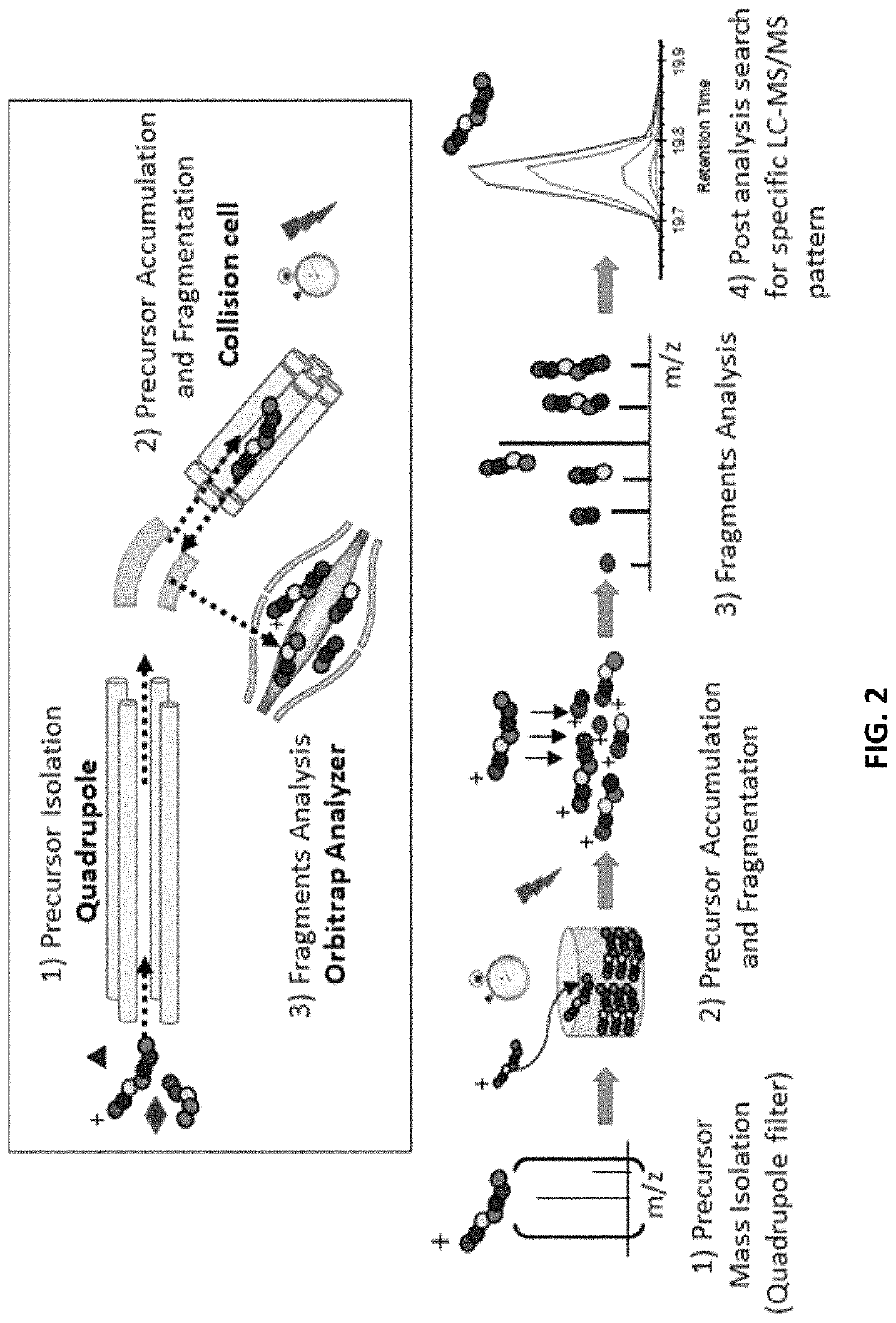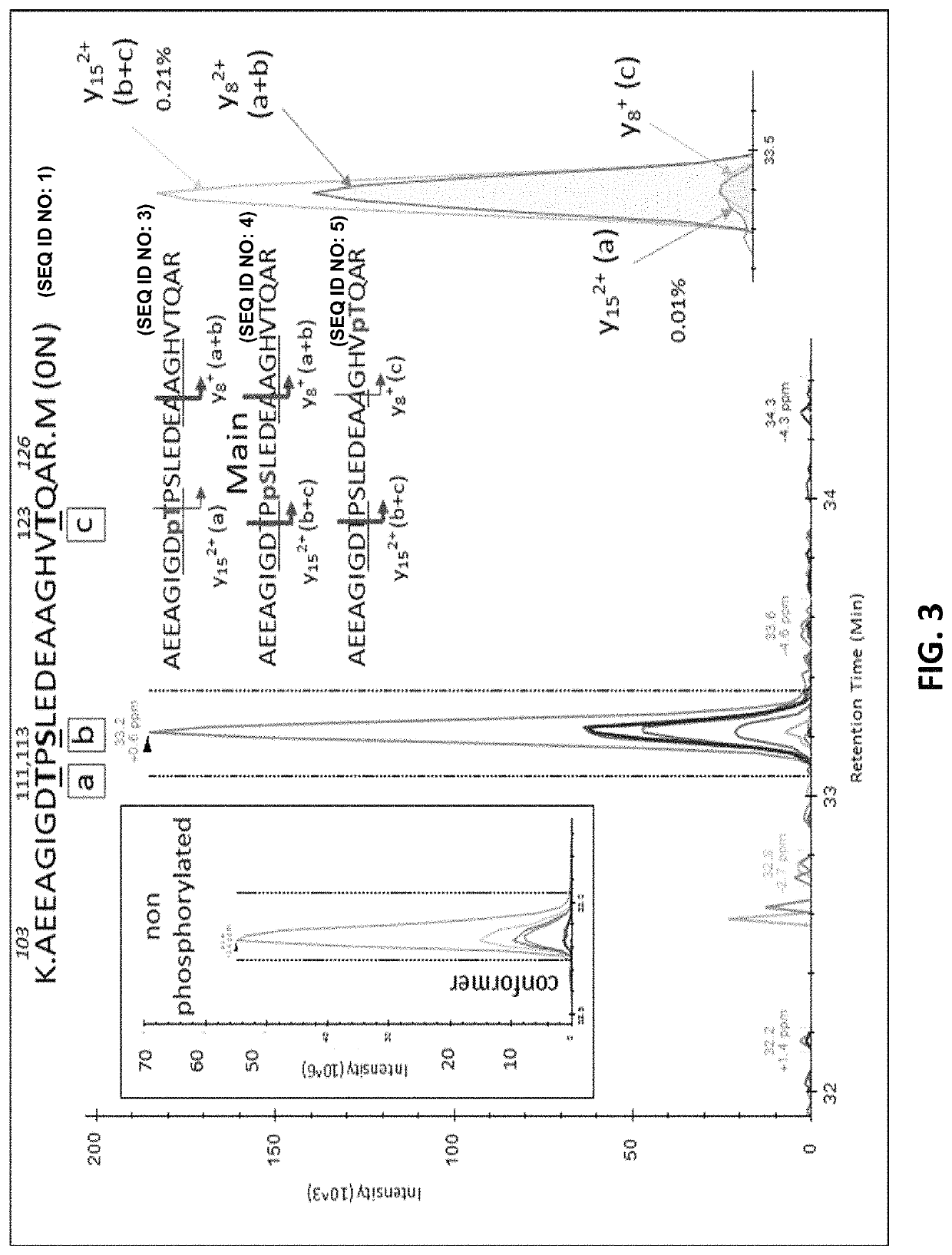Methods of treating based on site-specific tau phosphorylation
a phosphorylation method and tau technology, applied in the detection of post translational modifications, drug compositions, instruments, etc., can solve the problem of increasing the probability of tau aggregation, excessive phosphorylation of tau, etc., to increase the risk of conversion
- Summary
- Abstract
- Description
- Claims
- Application Information
AI Technical Summary
Problems solved by technology
Method used
Image
Examples
example 1
lation Sites on Tau Protein in the Normal Non-AD Human Brain
[0395]In order to determine phosphorylation sites of normal soluble brain tau, extracts from healthy controls were purified by immunocapture using Tau-1 and HJ8.5 tau antibodies concentrating both phosphorylated and unphosphorylated tau. The tryptic digestion of brain tau isoforms generated 27 unmodified peptides that were long and hydrophobic enough to be detected by LC-MS (Barthélemy et al., 2016). 25 peptides contained serine and / or threonine as potential phosphorylation sites. Several peptides contained multiple potential phosphorylation sites (4-9) leading us to consider different mono-phosphorylated peptides potentially co-eluting together during the LC separation. After this, the PRM screening method described above was applied to these peptides.
[0396]Results from analysis of the projection domains in the tau sequence (103-126) revealed multiple p-tau peptides eluting into overlapping complex LC-MS / MS patterns (FIG. ...
example 2
lation Sites on Tau Protein in the CSF
[0402]In comparison to the brain tau digest, CSF tau purification using tau-specific antibodies and digestion generated detectable peptides mainly from the mid-domain of the protein sequence (residues 150-221). Peptides were detectable to a lesser extent from the N-terminus, and almost no sequence was detectable from the microtubule binding repeat (MTBR) domain or the C-terminus of tau (Barthélemy et al., 2016; Sato et al., 2018). This difference in signal recovery may result from tau truncation during its release from neurons (Sato et al., 2018). The peptide recovery of this mid-domain was sufficient to monitor corresponding minor phosphorylated isoforms using the current PRM method. Conversely, a significant technological advance in MS method will be required to detect phosphorylated peptides in the MTBR and C-terminal domains.
[0403]PRM screening of tau phosphopeptides from normal control CSF identified several phosphorylation sites in common ...
example 3
Abundance Measurements Highlight Differences Compared to p-Tau Abundance in Brain
[0405]In the brain, S404 was the most highly phosphorylated of the examined phosphorylation sites (pS404 / S404=110%, i.e. 52% of S404 is phosphorylated). Thus, more than half of the brain tau was phosphorylated at S404 compared to other highly phosphorylated sites at S202 and T181 (9.7% and 9.5%, respectively). 1.3% of S199 was phosphorylated but this could be underestimated due to the inability of the Tau1 antibody used for extraction to bind its corresponding phosphorylated epitope (Liu et al., 1993). Phosphorylation on C-terminal sites other than S404 was found to be around 1%. On the N-terminus, T52, 568 / T69, T50, and S113 were also phosphorylated with abundances ranging from around 0.5% to 2%. Other detected sites appeared to be phosphorylated at much lower levels (<0.5%).
[0406]In addition to the unique detection of pT205 and pS208 in CSF tau but not brain, the relative phosphorylation abundance of ...
PUM
| Property | Measurement | Unit |
|---|---|---|
| concentration | aaaaa | aaaaa |
| temperature | aaaaa | aaaaa |
| temperature | aaaaa | aaaaa |
Abstract
Description
Claims
Application Information
 Login to View More
Login to View More - R&D
- Intellectual Property
- Life Sciences
- Materials
- Tech Scout
- Unparalleled Data Quality
- Higher Quality Content
- 60% Fewer Hallucinations
Browse by: Latest US Patents, China's latest patents, Technical Efficacy Thesaurus, Application Domain, Technology Topic, Popular Technical Reports.
© 2025 PatSnap. All rights reserved.Legal|Privacy policy|Modern Slavery Act Transparency Statement|Sitemap|About US| Contact US: help@patsnap.com



